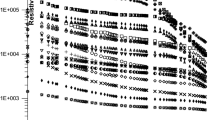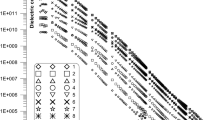Abstract
Electrode polarization is a major problem in the determination of dielectric properties of samples, particularly at low frequencies. Understanding of these interfacial phenomena is essential in order to measure correctly the electrical properties of a sample of interest. This paper presents a comparative study of the effect of electrode contact impedance on A.C. electrical properties of a partially and fully saturated hematitic sandstone sample. The electrical properties of the sample were first measured using stainless steel electrodes with high contact impedance, and measured again with a four terminal Cu–CuSO4 electrode of low contact impedance. Complex impedance measurements at room temperature (~16°C) were performed in the frequency range from 1 Hz to 100 kHz. Measured electrical spectra vary strongly with the electrode type. The difference in the electrical properties between the two electrode types (stainless steel and Cu–CuSO4) may be attributed to the surface contact impedance between the sample and the electrode. Experimental data indicate that the electrical properties vary strongly with water saturation. The dielectric constant decreases with frequency and increases with saturation up to a certain saturation limit then decreases. Charge transport can occur either through the bulk of the solid matrix (hematite or sand) or along the grain boundaries of aggregates (water). When soil minerals are exposed to water, exchangeable ions go into solution. Most of the ionic or covalent bonded rock forming minerals such as quartz, mica, and feldspars are nonconductors. When the surfaces of these minerals come into contact with liquid water, electrolytes are formed and ionic drift associated with the electrical field causes electrical conduction. The anomalous dielectric properties of partially saturated rocks can be interpreted using percolation theory. This theory predicts that when the conductive fraction (water) increases, clustering of conductive inclusions develops, and the thickness of insulating gaps between conductive clusters decreases, causing a large increment in the capacitance of the sample. Further increases in the conductive component causes the shunting of insulating capacitive gaps.













Similar content being viewed by others
References
Alikaj P (1989) The study of spectral characteristics of induced polarization in search for high grade sulphide ore bodies, Ph. D. thesis in Albanian. Polytechnic University of Tirana, Albania
Attia MI (1955) Topography, geology and iron-ore deposits of the district east of Aswan. Geol Surv, Cairo, Egypt, p 262
Chelidze T, Gueguen Y (1999) Electrical spectroscopy of porous rocks: a review—I. Theoretical models. Geophys J Int 137:1–15
Chelidze T, Gueguen Y, Ruffet C (1999) Electrical spectroscopy of porous rocks: a review—II. Experimental results and interpretation. Geophys J Int 137:16–34
De Lima OAL (1995) Water saturation and permeability from resistivity, dielectric, and porosity logs. Geophysics 60(6):1751–1764
De Lima OAL, Sharma MM (1991) Water conductivity and saturation effects on the dielectric response of shaly sands, 32nd Ann. Log. Symp. Trans., Soc. Prof. Well Log Analysts, Paper G
De Lima OAL, Sharma MM (1992) A generalized Maxwell-Wagner theory for membrane polarization in shaly sands. Geophysics 57:789–799
Efros AL, Shklovskii BI (1976) Critical behaviour of conductivity and dielectric constant near the metal–non-metal transition threshold. Phys Status Sol 76:475–489
Fricke H (1972) The theory of electrolytic polarization. Phil Mag 14:310–318
Gomaa MM (2004) Induced polarization Study on iron ore bearing rock samples. Ph. D. Thesis, Cairo University, Egypt
Gomaa MM (2006) Interpretation of electrical properties for humid and saturated hematitic sandstone sample, presented at the 68st conference and exhibition incorporating SPE Europe: European association of geoscientists and engineers (EAGE), oral H021, Session “gravity, magnetics, mining and geothermal”, 12–15 June, Vienna, Austria
Gomaa MM (2007) Electrical properties of a homogeneous mixture of hematite and sand with different concentrations in the frequency domain, Paper presented at the 5th international symposium on geophysics (ISG-5), held on Tanta University, Egypt, Session G “Electric methods”, Nov. 27–29, 2007
Gomaa MM (2008) Relation between electric properties and water saturation for hematitic sandstone with frequency. Annals of Geophysics 51(5/6):801–811
Gomaa MM (2009) Saturation effect on electrical properties of hematitic sandstone in the audio frequency range using non-polarizing electrodes. Geophys Prospect 57:1091–1100
Gomaa MM, Elsayed RM (2009) Thermal effect of magma intrusion on electrical properties of magnetic rocks from Hamamat sediments, NE Desert, Egypt. Geophys Prospect 57(1):141–149
Grant FA (1958) Use of complex conductivity in the representation of dielectric phenomena. J Appl Phys 29:76–80
Hoekstra P, Doyle WT (1971) Dielectric relaxation of surface adsorbed water. J Colloid Interface Sci 36:513–521
Jonscher AK (1999) Dielectric relaxation in solids. J Phys D Appl Phys 32:R57–R70
Knight R (1983) The use of complex plane plots in studying the electrical response of rocks. J Geomag Geoelectr 35:767–776
Knight R, Abad A (1995) Rock/water interaction in dielectric properties: experiments with hydrophobic sandstones. Geophysics 60(2):431–436
Knight RJ, Endres AL (1990) A new concept in modeling the dielectric response of sandstones: defining a wetted rock and bulk water system. Geophysics 55:586–594
Knight RJ, Nur A (1987) The dielectric constant of sandstones, 50 kHz to 4 MHz. Geophysics 52:644–654
Kohlrausch F, Holborn L (1898) Das Leitvermoegen der Elektrolyte. Teubner, Leipzig, p 160
Levitskaya MT, Sternberg KB (1996a) Polarization processes in rocks 1. Complex dielectric permittivity method. Radio Science 31(4):755–779
Levitskaya MT, Sternberg KB (1996b) Polarization processes in rocks 2. Complex dielectric permittivity method. Radio Science 31(4):781–802
Levitskaya TM, Sternberg BK (2000) Application of lumped-circuit method to studying soils at frequencies from 1 kHz to 1 GHz. Radio Science 35(2):371–383
Olhoeft GR (1985) Low frequency electrical properties. Geophysics 50:2492–2503
Parkhomenko EI (1967) Electrical properties of rocks. Plenum Press, New York
Parks GA (1990) Surface energy and adsorption at mineral-water interfaces: an introduction. In: Hochella MF, White AF (eds) Mineral-water interface geochemistry: Mineralogical Society of America, Reviews in Mineralogy 23, 132–174
Pride S (1994) Governing equations for the coupled electromagnetics and acoustics of porous media. Phys Rev B 50(1):15678–15696
Schwan HP (1992) Linear and nonlinear electrode polarization and biological materials. Ann Biomed Eng 20:269–288
Scott JH, Carroll RD, Gunningham DR (1964) Dielectric constant and electrical conductivity of moist rock from laboratory measurements, US Dept. of interior geological survey technical letter, Special projects-12, August. 17, (US Air force, Sensor, simulation notes, SSN 116)
Sen PN (1981) Dielectric anomaly in inhomogeneous materials with application to sedimentary rocks. Appl Phys Lett 39(8):667–668
Sen PN (1984) Grain shape effects on dielectric and electrical properties of rocks. Geophysics 49:586–587
Sen PN (1989) Unified models of conductivity and membrane potential of porous media. Phys Rev B 39(13):9508–9517
Shukri NM, Ayouty A (1959) The mineralogy of the Nubian Sandstone in Aswan. Bull Instit Desert Egypt 3(2):65–88
Warburg E (1899) Ueber Das Verhalten sogenannter unpolarisierbarer Elektroden gegen Wechselstrom. Ann d Physik 67:493–499
Warburg E (1901) Ueber Die Polarisations kapazitaet des Platins. Ann d Physik 6:125–135
Author information
Authors and Affiliations
Corresponding author
Rights and permissions
About this article
Cite this article
Gomaa, M.M., Alikaj, P. Effect of electrode contact impedance on A.C. electrical properties of a wet hematite sample. Mar Geophys Res 30, 265–276 (2009). https://doi.org/10.1007/s11001-010-9092-y
Received:
Accepted:
Published:
Issue Date:
DOI: https://doi.org/10.1007/s11001-010-9092-y




